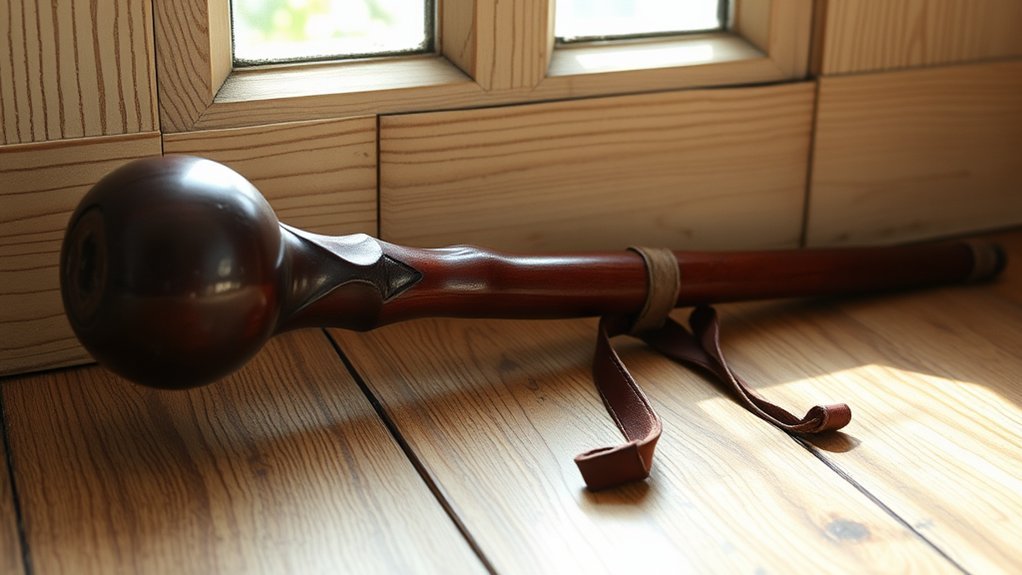Shillelagh
The shillelagh, a traditional Irish walking stick made mainly from blackthorn wood, symbolizes resilience and identity for the Irish people. I find it fascinating how this strong piece of timber has served not just as a walking aid but also as a weapon throughout history. The craft of making a shillelagh involves unique curing techniques that enhance its durability. Its significance extends into folklore and modern culture, reflecting a deep-rooted heritage. There's so much more to uncover about its history and impact.
Key Takeaways
- A shillelagh is a traditional Irish walking stick or weapon, often made from durable blackthorn wood.
- Its name derives from Hiberno-English, meaning "willow strap," and is linked to Irish identity.
- Historically, shillelaghs served both as self-defense tools and cultural symbols, especially during the Penal Laws.
- The art of Bataireacht, or stick fighting, evolved around shillelaghs, reflecting their role in social conflicts.
- Today, shillelaghs are used as walking aids, in martial arts, and as symbols of Irish heritage in celebrations.
Etymology
The term "shillelagh" is steeped in rich history and cultural significance. Originating from the Hiberno-English "sail éille," it combines "sail," meaning willow, and "éille," a strap or thong. This connection not only highlights its practical use but also reveals a deeper narrative tied to County Wicklow, where the name may trace back to the local timber.
Additionally, "Síol Éalaigh," or "Descendants of Éalach," anchors the shillelagh within Irish identity. Historical texts and folklore, particularly by Anna Maria Hall and Patrick Weston Joyce, enrich our understanding of the shillelagh as both a weapon and a walking aid, symbolizing resilience.
Construction

Crafting a shillelagh is an intricate process that reflects both tradition and skill. I've found that blackthorn wood is the preferred choice, prized for its durability and the unique knobs formed from its root.
When constructing a shillelagh, I often use traditional curing methods—like hanging it in a chimney for months—to dry and strengthen the wood. Other techniques, such as brining with saltwater or using dung piles, enhance its resilience.
Sometimes, I even smear the stick with butter before curing, a method that seems strange but really aids in the crafting process, resulting in a strong, beautiful shillelagh.
History

While exploring the rich tapestry of Irish history, one can't overlook the shillelagh's role as both a weapon and a cultural symbol. Originating from the term "sail éille," it's crafted from blackthorn or willow, serving as a cudgel for self-defense over a millennium.
With Penal laws prohibiting weapons, shillelaghs cleverly transformed into faux-walking sticks, allowing individuals to navigate societal constraints. The art of Bataireacht, developed through centuries, highlights its significance in social conflicts.
Beyond its practical use, the shillelagh embodies Irish identity, woven into folklore and songs, reflecting the cultural significance cherished by the Irish diaspora and beyond.
Folklore and Balladry

Shillelaghs have long danced through the verses of Irish folk songs, embodying the spirit of brawls and camaraderie. These traditional ballads, like "The Twig of Shelaly" and "Arthur McBride," celebrate not just fights but the artistry in shillelagh craftsmanship.
Through folklore, we see the term "shillelagh law" emerge, reflecting the informal rules guiding their use in disputes. This cultural significance resonates deeply with Irish-American heritage, as shillelaghs symbolize resilience and identity.
As I listen to these songs, I feel the weight of history and the vibrant spirit of a people who turned their struggles into art.
Modern Use

In recent years, shillelaghs have transcended their traditional roots, finding a place in modern culture as both symbols of heritage and practical items.
I've noticed members of the Irish Guards and the Royal Irish Regiment proudly carry shillelaghs, showcasing their cultural significance. They also feature prominently in parades by the 69th Infantry Regiment, emphasizing Irish-American pride.
Beyond tradition, shillelaghs serve dual purposes: as walking aids and in martial arts, linking past fighting techniques to present-day practice.
Modern interpretations, like personalized decorative items and lucky charms, keep the spirit alive, blending history with contemporary folklore and spirituality.
Frequently Asked Questions
What Was a Shillelagh Used For?
A shillelagh's uses span from a traditional weapon in historical battles to a walking stick symbolizing Irish folklore. Its craftsmanship techniques highlight cultural significance, while modern adaptations embrace it in sports and ceremonial art.
How Do You Pronounce Shillelagh in Irish?
When I immerse myself in the rich tapestry of Irish pronunciation, I find "shillelagh" flows as "shi-lay-lah," a melodic echo of our linguistic roots—preserving cultural significance, folklore stories, and the legacy of traditional weapons across regional dialects.
Are Shillelaghs Legal in Ireland?
In Ireland, the legality of carrying a shillelagh hinges on its use. While I appreciate its rich history and craftsmanship, I know its symbolism and variations must align with local laws to avoid legal entanglements.
What Is the Shillelagh Law?
The Shillelagh Law embodies a rich tapestry of Shillelagh history and culture. Its significance lies in traditions and craftsmanship, showcasing variations, techniques, and festivals that celebrate its symbolism, promoting fairness in conflict while honoring community values.
Conclusion
In wrapping up our journey through the world of the shillelagh, I can't help but feel its rich history and folklore dance like shadows around us. From its sturdy construction to its spirited role in tales and modern life, this humble stick embodies resilience and tradition. As I reflect on its significance, I realize the shillelagh isn't just a tool—it's a bridge connecting generations, whispering stories of the past while still standing strong in the present.







